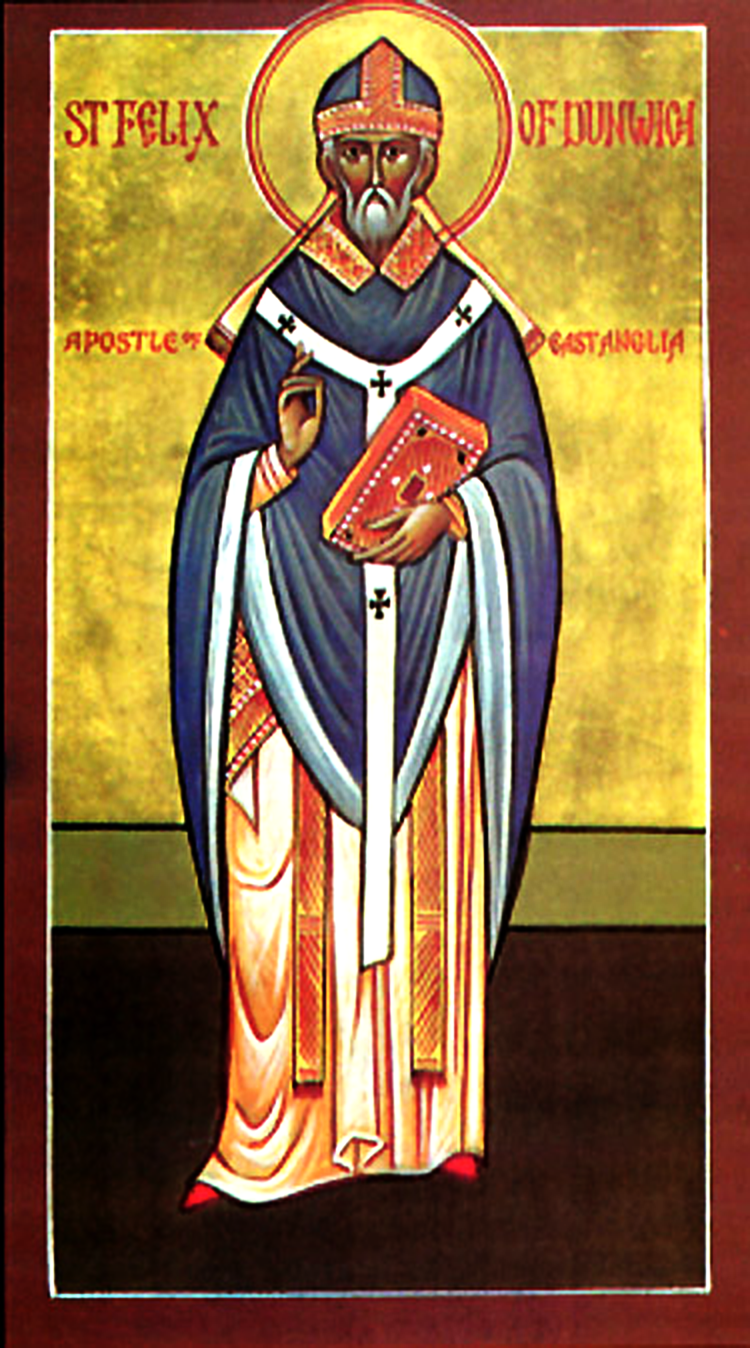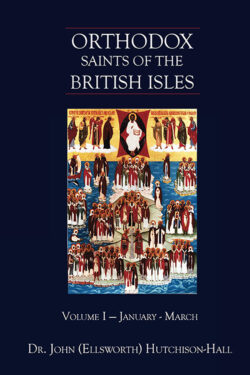
Orthodox Saints of the Pre-Schism
See of Rome
21st March (NS) — 8th March (OS) 2024
BEOADH (BEATUS), a Bishop of Ardcarne in Co. Roscommon, Ireland, few facts are known of St. Beoadh’s life. Traditionally he has been renowned for his piety and the miracles that are associated with him. It is believed that he reposed sometime between 518 and 523.
CYRIL, ROGATUS, FELIX, ANOTHER ROGATUS, BEATA, HERENIA, FELICITAS, URBAN, SILVANUS, and MAMILLUS, (Date Unknown), St. Cyril, a bishop, and members of his flock, martyred in North Africa. Nothing is known of them aside from these names.
Troparion of St. Felix of Dunwich
Tone VIII
Felix of Burgundy, hierarch and teacher, preaching the Word of life,
You did gather a rich harvest of believers;
Together with Furzey of Ireland, pilgrim for the love of the Lord,
Outstanding in virtue, renowned in word and deed;
Enlighteners of East Anglia, we rightly praise you, holy and God-bearing fathers.
Kontakion of St. Felix of Dunwich
Tone II
Having come to the land of Sigebert, the righteous king,
You preached the kingdom of Christ our God,
And as a first-fruit the king himself received the tonsure,
Seeking an everlasting kingdom;
And mindful of his monastic vow,
He lay down his life, unarmed in the midst of battle;
Wherefore, O Felix and Furzey, we venerate your memory crying out:
Glory to Christ our King the Redeemer of the World!
FELIX of DUNWICH, a native of Burgundy, who, after converting the then-exiled East Anglian prince who would become St. Sigeberht (25th January), King of the East Angles (r. 630/1–654), made his way to England. Establishing his See at Dunwich in Suffolk, St. Felix laboured there for seventeen years, successfully preaching the Gospel to the heathen in East Anglia. He founded a school for boys with the help of King St. Sigebert, which he staffed with teachers from Canterbury. St. Felix reposed in 648 and was buried at Dunwich; his relics were translated to Ramsey in 971. St. Felix has given his name to Felixstowe in Suffolk, and to Felixkirk in Yorkshire.
HUNFRID (HUMFRIDUS, HUMPHREY), a monk at Prüm Abbey (Fürstabtei Prüm) in Lorraine (present-day Roman Catholic Diocese of Trier, Germany). In 856 Pope Nicholas I promoted a reluctant St. Hunfrid to Bishop of Thérouanne in Gaul. Forced to flee his See during a Norman invasion, St. Hunfrid returned to assist with the city’s restoration and serve as Abbot of St. Bertin Abbey (abbaye Saint-Bertin). St. Hunfrid reposed in 871.
JULIAN of TOLEDO, consecrated the thirty-fourth Archbishop of Toledo in 680, St. Julian presided over several important councils at Toledo, and played a significant role in revising the Mozarabic Liturgy. A prolific writer, St. Julian is best remembered for his Prognosticum Futuri Saeculi (a treatise on Christian Eschatology), and Historia Wambae regis (a history of King Wamba of Spain’s accession to the throne and early reign). St. Julian reposed in 690.
PONTIUS, St. Cyprian’s (16th September) deacon, St. Pontius accompanied St. Cyprian into exile from Carthage in North Africa and witnessed his trial and execution. He later wrote a Life of St. Cyprian. St. Pontius reposed circa 260.
PROVINUS, a disciple of St. Ambrose (7th December) in Milan who served as St. Felix’s (14th July) co-adjutor and, following St. Felix’s repose, Bishop of Como. St. Provinus reposed circa 420.
RHIAN (RANUS, RIAN), (Date Unknown), the saint for whom Llanrian in Pembrokeshire is named. He has been described as an abbot by both, chronicler William of Worcester (†1482) and antiquarian John Leland (†1552). Neither specific dates nor particulars of his life are ascertainable.
SENAN (SENAMES), one of the 'Twelve Apostles of Ireland', St. Senan was a disciple of St. Natalis (27th January) and a monk, possibly an abbot, Cassidus. After finishing his studies, he established a monastery on the Island of Inniscorthy (Leinster), he then visited Rome and Gaul, and on his return spent time with St. David (1st March) in Wales. Returning to Ireland, he founded more churches and monasteries, notably one in Iniscarra near Cork, finally settling on Scattery Island in the Shannon estuary, where he reposed circa 540.
Get your copy of Orthodox Saints of the British Isles today.
Available at Amazon or your favourite e-bookstore.
BENEDICT of NURSIA
Father of Western Monasticism.
The only authoritative life of St. Benedict extant is by St. Gregory the Dialogist (3rd September) in the second book of his Dialogues, and this is more of an outline of important episodes in St. Benedict’s life, than a proper vita. According to tradition St. Benedict and his sister St. Scholastica (10th February) were twin children of a Roman noble, born in Nursia, near Spoleto. When St. Benedict was most likely in his early twenties, he left behind secular concerns to devote himself to God, and went to live as a hermit in a cave near Subiaco. There he was a spiritual child of the near-by hermit, St. Romanus of Subiaco (22nd May), who also tonsured him into monasticism.
In time, his holiness and fame as a wonderworker, drew many disciples to him and he built a lavra, for them. Around 530 he left Subiaco for Monte Cassino, where he founded the famous monastery, where he also composed his Rule, which, though initially was resisted by many as too harsh, came to be adopted by tens of thousands of monasteries the world over.
St. Benedict spent the rest of his life at Monte Cassino. St. Benedict reposed while standing in prayer before the altar in 550. St. Benedict was buried at Monte Cassino, though some of his relics were later translated to France.
Troparion of St. Benedict of Nursia
Tone I
By your ascetic labours, God-bearing Benedict, / you were proven to be true to your name. /
For you were the son of benediction, /
and became a rule and model for all who emulate your life and cry: /
“Glory to Him who gave you strength! /
Glory to Him who granted you a crown! /
Glory to Him who through you grants healing to all!”
Kontakion of St. Benedict of Nursia
Tone VI
You were enriched with God’s grace; /
your works agreed with your name, O Benedict, helpful servant of Christ God. /
Through prayer and fasting you were revealed to be filled with the gifts of the Spirit of God! /
You are a healer of the sick, the banisher of demons and speedy defender of our souls!
BIRILLUS of CATANIA, he is traditionally considered to have been consecrated first Bishop of Catania in Sicily by the Apostle Peter (29th June) circa 42. St. Birillus is reputed to have been exceptionally successful in his evangelising the local pagans and reposed in extreme old age, circa 90.
ENDA (ENDEUS, ENNA) of ARRAN, the brother of St. Fanchea (1st January), St. Enda founded many of the earliest monasteries in Ireland. His principal monastery was at Killeany in the Arran Islands. SS. Kyran of Clonmacnoise (9th September) and Brendan the Voyager (16th May) were amongst his disciples. St. Enda reposed circa 530.
LUPICINUS of CONDAT, the brother of St. Romanus of Condat (28th February), with whom he founded the Abbey of St. Claude, often called Condat Monastery, in Saint-Claude in the French Jura, and the nearby Laconne Monastery (in the present-day canton of Saint-Lupicin) as well. St. Lupicinus’ sanctity and miracles were attested to in detail by St. Gregory of Tours (17th November) in his writings. St. Lupicinus reposed circa 480.
PHILEMON of ROME and DOMNINUS of ROME, (Date Unknown), Although there are no reliable sources for their Lives extant; they are traditionally believed to have been two Romans who wandered through Italy preaching the Gospel, and were arrested by the Roman authorities who put them to death.
Prior to the Schism the Patriarchate of Rome was Orthodox, and fully in communion with the Orthodox Church. As Saint John of Shanghai and San Francisco +1966 said “The West was Orthodox for a thousand years, and her venerable Liturgy is far older than any of her heresies”.
Details of British Saints excerpted from Orthodox Saints of the British Isles.
Details of continental saints from these sources.
In many cases there are several spelling versions of the names of saints from the British Isles. I use the Oxford Dictionary of National Biography version as the primary version with the more prevalent version in parenthesis e.g. Ceadda (Chad) of Lichfield.



